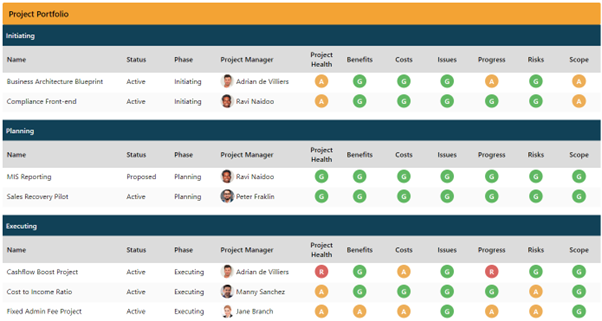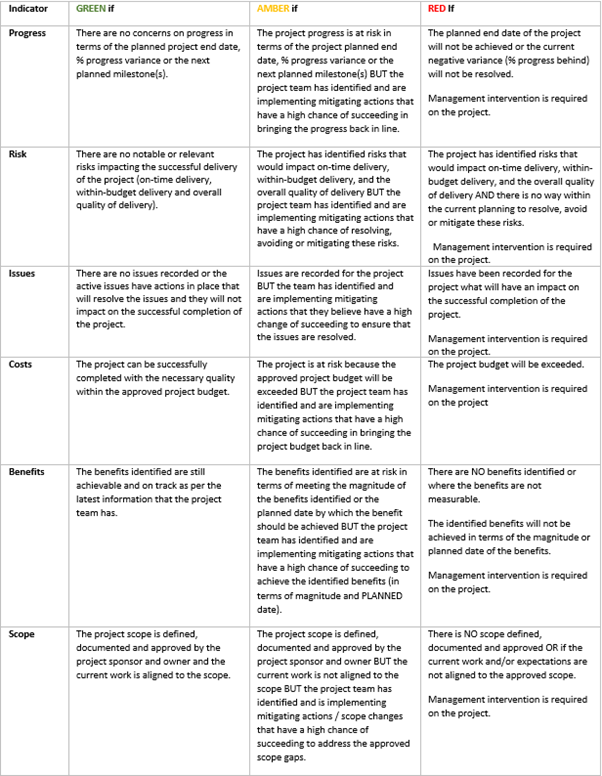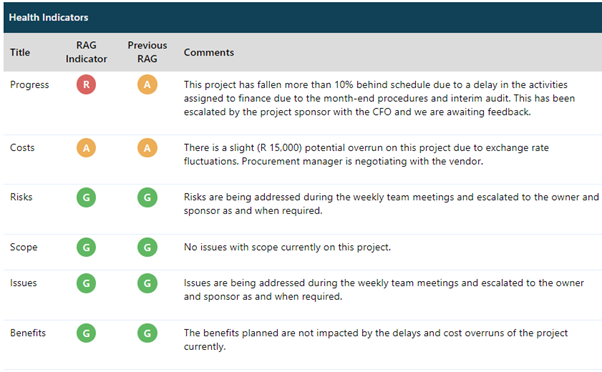The RAG acronym stands for RED, AMBER, GREEN. These colours make up the traffic light colours used by most project managers to convey their subjective view of a project’s status. A RED traffic light normally indicates there are problems on the project (or an aspect of it); AMBER indicates there are issues that are being dealt with by the team but acts as a warning, and GREEN generally indicates that everything is okay.
Each colour also requires a different action from management and are thus key in project and portfolio status reporting.
How should organisations use RAG statuses in project reporting?
Step 1 – Identify Which RAGs to Report On
It’s rare that looking at a single health indicator will give you the full view and understanding of the status of a project. Project managers must consider various perspectives when reporting on a project, these include perspectives like Scope, Progress, Risks, Costs, Benefits, etc and of course, the overall project health. Using a reporting guideline (more about this later), the project manager gives their assessment of the project’s performance against each of these indicators.

To ensure that you’re able to do portfolio reporting (reporting across multiple projects), all projects must report on the same RAGs and thus you must define the list and be consistent across all projects. So, step 1 is deciding which perspectives you want to report on and get those listed as your Health Indicators.
Step 2 – Develop a RAGs Guideline
To support the project managers to report on each RAG that you have chosen, it’s recommended that project management offices (PMOs) introduce a guideline for how to determine the appropriate RAGs for each individual indicator.
Having a documented reporting guideline avoids different interpretations of what the colours mean. For example, I’m generally more conservative and tend to use AMBER and RED at the earliest sign of trouble while some project managers that I’ve worked with are more risk takers and only use RED when the project is unsalvageable which is often too late! Here is a simple guideline of a RAG guideline with the appropriate management action which is a good starting point and can be applied to numerous RAGs.

For more mature PMOs a guideline per RAG is recommended, similar to the example below:

What you’ll realise when determining the guideline is that it’s very difficult to define a simple calculation or formula for all your chosen health indicators. While indicators like Cost and Progress might be easy it’s almost impossible to define a calculation for scope and team alignment. This is one of the reasons that we don’t calculate health indicators in PPO.
Step 3 – Define how the Overall Project Health is determined
The Overall Project Health is represented by a single RAG which has to convey the overall status of the project. My recommendation (and the PPO out-of-the-box standard) is that the Overall Project Health be calculated using the “worst case basis” of the individual health indicators. What this means is that if any individual health indicator is RED, then the overall project will be RED and if there are no RED indicators but at least one AMBER, then the overall indicator is AMBER. This tells management, that something on this project is RED and requires their attention.
I recommend avoiding complex weightings (which some PMOs have tried) as these rules typically don’t cater for all types of projects and sizes or consider the current phase of the project. The complex weighting is also in most cases poorly understood by management who are reading the reports and thus a lot less effective.
Step 4 – Introduce a Consistent Reporting Heartbeat
Good PMOs develop a sustainable reporting heartbeat. Getting consistency is a key first step and something PMOs should focus on. Referencing 5 Simple Steps to Project Status Reporting that People will Read, “If the status is not timely or in a format that that your audience understands, it is meaningless! Status updates should never be erratic. Then also deliver it consistently on a regular heartbeat, for example every Thursday for team reporting and the 2nd Friday of every month for SteerCom reporting. Once stakeholders get the hang of it, they consistently know what to expect and when.”
In addition, the consistent application of the guideline must be very entrenched. PMOs should focus on reviewing the project health indicators, as reported by the project managers on a constant basis and ensuring that the project managers are consistently applying the guidelines. A 5% progress variance on a 3-year project would be considerable number of hours delay compared to a 5% progress variance on a 4-month project.
What I’ve experienced is that when a reporting heartbeat is introduced, the quality of the overall project and portfolio data improves. By getting the project managers into a habit of reporting every week or every two weeks, the habit of reviewing your project data (schedules, work items, risks, issues, costs) is formed and this data is naturally updated by the project managers, when doing their reporting, One of the big problems with PMOs that calculate or automate their health indicators is that the calculation (if you can determine one based on my experiences in step 2) is based on the underlying data and if that data is outdated (risks are not raised that exist, issues have been updated and schedules are not accurate) then the calculated health indicators are meaningless, and in most cases go RED, resulting in a large amount of RED in your portfolio report, causing a lot of unnecessary panic and “cry wolf” in your organisation.
Step 5 – Improving Story Telling of the Project Managers
A good project manager can communicate a clear and accurate view of the status of their project to management, but what I’ve experienced is that it’s dependent on the PMOs focus and guidance to project managers on story telling.
Once the guideline has been developed and the reporting heartbeat is consistent, the PMO should focus on ensuring that the guideline is correctly applied. This involves regular reviews of the project health indicators, as reported by the project managers and ensuring that the guidelines are correctly applied. The benefit of this PMO activity is that you will naturally do a review of all the underlying project information (schedules. costs, benefits, risks etc) and gain a better understanding of the status, but the most important focus of these reviews should be the WHY and the WHAT NOW.
When a specific health indicator is AMBER or RED the key for the project manager is to explain WHY the indicator is not GREEN and what they and their teams are planning to do to rectify and get the indicator back to GREEN. If a project is projected to be completed 6% over budget, I know that it means that the total cost at completion will be 6% more than the approved budget but what I don’t know is WHY. Did we under budget it? Was there a cost escalation we had to accept? Was there wasted expenditure on the project that resulted in the increase cost? Did we have to redo work due to a quality problem, and thus pay twice for the same thing. The comments that the project manager provides this content. In addition, the health indicator comment should also provide management with assurances that the project manager and their teams have actions in place to rectify or have a very clear shout for help from management, when it’s required. We want our project managers to take responsibility for their project and that show this in the commentary and reporting that they provide.

A common problem with PMOs that automate their health indicators is that they believe they are saving the project managers time by calculating the health indicator, but a calculated health indicator can never provide the WHY and the WHAT NOW. Thus, no time is saved by automating them. In fact, time is lost because the project manager will spend more time responding to queries and concerns by the PMO and project community on why certain indicators are AMBER or RED without the context.
If you’ve followed these 5 steps, the first three steps, once off in the beginning, with maybe a review every year or so, and the last two steps on a regular basis until it’s well entrenched, your portfolio and project information will improve, your project managers will take more responsibility for their projects and the reporting, and your project community and management team will feel the value of the PMO and the project managers.
I’d love to hear your views and experiences around establishing project health indicators.


